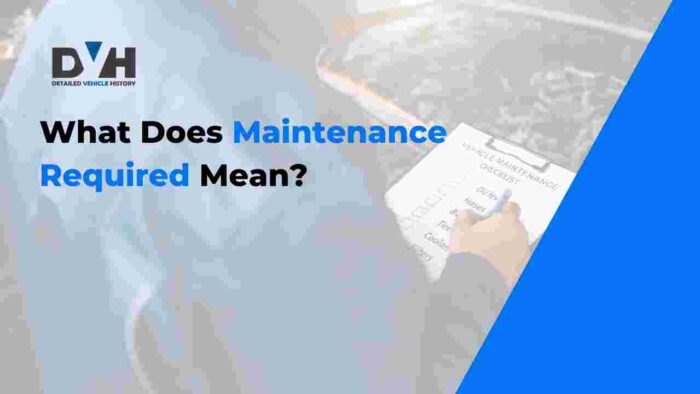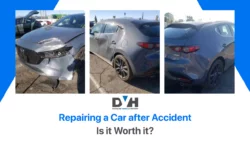Driving down the road, you suddenly see a light pop on your dashboard. It can be scary if you don’t know what that light means. The maintenance required light will come on to let you know it needs attention, or there may be more significant problems if you fail to take action against the signal.
Knowing why this light is on will give you an edge over such a circumstance that may get out of hand. This article will break down the importance of this light and the others on your dashboard and guide you through the next course of action.
RELATED: 7 Reasons Why ABS and Traction Control Lights Are On
Why is the Maintenance Required Light in My Car On?
When the maintenance required light comes on, it usually means your car needs servicing soon. The ‘Maintenance Required’ light reminds you to have a check-up of your car’s vital systems.
This can be activated for many reasons, from an oil change to a tire rotation. It might also mean that your vehicle is approaching its scheduled maintenance interval.
- Most modern cars have an onboard computer that monitors various systems. This computer tracks the miles one has driven since the last service was due. After attaining a given mileage, the maintenance light is turned on.
- Moreover, some vehicles record driving habits like hard acceleration and hard braking. These driving practices can wear components out faster, thus making the light turn on.
- The maintenance-required light is often part of your car’s overall maintenance schedule. The maintenance schedule serves to maintain optimum functionality and may include anything as small as checking fluids, brakes, and belts.
The maintenance required light encourages proactive maintenance that can help eliminate more serious problems down the road.
RELATED: Electric Car Maintenance Tips You Need To Know
What Will Happen If You Ignore the Maintenance Required Light?
Ignoring the maintenance-required light is like ignoring a cough. It may be minor at the beginning, but soon enough, much bigger health problems arise.
Ignoring your car’s maintenance light can quickly lead to serious problems down the road. For instance, low oil levels or dirty filters may be affecting performance and fuel efficiency. However, something as simple as an oil change can prevent issues like engine overheating.
Moreover, if you skip maintenance, you’re setting yourself up for bigger surprises. As a result, overheating could lead to a blown head gasket or other serious damage. In the long run, these repairs cost far more than routine maintenance.
Additionally, paying attention to the maintenance light can also prevent costly repair bills. On the other hand, missing important services can lead to a breakdown, leaving you stranded and paying high towing costs.
Furthermore, poor maintenance can seriously impact your safety. Neglected brakes, steering, or other critical systems could fail while you’re driving, ultimately putting you in a dangerous situation.
Ensure you take action the day the maintenance-required light appears before your eyes to keep your car in good condition and at top performance.
Dashboard Lights You Can’t Ignore
Your car has a number of lights on the dashboard that are meant to grab your attention, and each of these has a purpose. Let’s talk about some key lights on your dashboard that you simply can’t ignore.
Check Engine Light
If your check engine light is on, your engine has a problem. It may be minor in nature because it can be anything from a loose gas cap to an engine problem.
More seriously, it could even be from your fuel system, ignition system, or catalytic converter. Whether you’re driving a Toyota, Mercedez, or any car brand, it’s not advisable to keep driving with the check engine light ON.
It’s always best to get this checked out immediately. The good thing about this is that many auto parts stores will read your trouble codes for free.
Engine Oil Level
Your check engine oil level light is a warning that your oil levels are low. If the levels get too low, this can cause severe damage to your engine. If you see this light, you should pull over and check your oil level as soon as possible.
If you continue running your engine with low oil, you risk causing increased friction and heat. You can easily avoid this problem by checking your oil levels. Try to check your oil once a month at a minimum and before taking extended trips.
ABS Light
The ABS or Anti-lock Braking System light lets you know something is wrong with your braking system. You should not ignore this light as it can impact the vehicle’s ability to come to a safe stop.
It could mean your ABS is not working properly or your brake fluid is too low. Have this looked at immediately for your protection. Your brakes are the most important part of your car’s operation.
Door Ajar
The door ajar light means one of your doors isn’t closed properly. While it might be minor, it’s going to create safety problems. If you are driving around with a door open, it may become a severe safety hazard.
Always check that all the doors are closed appropriately before you start driving. This light will also drain your battery if you leave it on without notice due to the interior lights being on.
Power Steering Light
Power Steering Light tells you that there is a problem with your steering. If this light comes on, you can experience hard times while steering your car. This may put you in dangerous situations, especially when the maneuvers need to be done urgently. These may be due to either low power steering fluid or a failing pump. This needs to be checked and addressed the minute you notice it.
Airbag Warning Light
The airbag warning light indicates a problem with your airbag system. This can result in airbags failing to deploy during an accident. The problem may be a malfunctioned sensor or possibly a problem in the airbag itself. This light should never be ignored, as it is a matter of safety. Your safety in an accident will be at risk if your airbag system is compromised.
Cooling System
The cooling system light indicates that your engine may overheat. If you noticed this, steer to the side of the road as soon as possible. Overheating may cause engine damage,giving rise to a complete failure in an engine that oculd costs much to put right. To avoid this, always check the temperature gauge and coolant levels.
Automatic Transmission System Warning
The automatic transmission warning light shows up when there is an issue with your transmission. Failure to diagnose will lead to transmission failure, costing you thousand of dollars on repairs.
The light may appear when the level of transmission fluid is low, or it overheats. If this happens, take immediate action to fix it as this might make driving the car impossible.
Seat Belt Reminder
A Seatbelt Reminder is a subtle cue to buckle up. When on the road, wear your seat belt at all times. It is essential for your protection and the individuals traveling inside the car. Seat belts could save your life during a collision; hence, you must inculcate the driving habit of buckling up.
Headlight System Malfunction
The malfunctioning headlight system means one or more of your headlights are out. This can decrease your visibility at night. It is unsafe to drive this way, and it can get you pulled over by the police. Replace any burnt-out bulbs as soon as possible for safe driving. Make sure you take care of your car and check on your headlights regularly.
How Much Will It Cost When the Maintenance Required Light Comes On?
Servicing the vehicle can cost a lot. It really depends on the car’s make and model and what needs to be fixed. Routine maintenance, such as oil changes, can cost under $100. However, if you neglect the light for required maintenance, the actual repair may cost more later.
For example, missing an oil change can result in major engine repairs that run into thousands of dollars. Another example could be skipping over replacing worn brake pads, which may damage your rotors. This would mean a full brake replacement, which is far more costly.
If you’re considering a used car, it usually pays to know the vehicle’s history. For instance, a detailed vehicle history report can include estimates for the cost of repairs. Knowing what to expect will help you budget maintenance and repairs effectively. A vehicle report will give you insight into previous maintenance and repairs. This may help you avoid buying a car with hidden problems.
Also, having a record of your maintenance will help identify trends. If a certain part has a history of failure and you want to replace it, proactive maintenance is often cheaper.
Conclusion
The maintenance-required light helps keep your car performing excellently. Neglecting it may set you up for expensive repairs, in addition to causing you a headache.
Similarly, give due attention to other warning lights on your dashboard. Routine maintenance will always pay off with huge savings in place of those spur-of-the-moment and unbudgeted repairs.
Moreover, if you’re buying a used car, the safest purchase and driving begins by using a reliable VIN check tool to verify service and maintenance records and actual mileage, which are necessary to make informed choices in keeping the vehicle running smoothly.
READ ALSO: How to Check if a Car Has Been in an Accident
Frequently Asked Questions
It is like a warning to take action. Although it may not be an urgent problem, it can develop into serious issues like engine breakdown and transmission failure if neglected.
Your maintenance required light can illuminate for a multitude of reasons. It may mean you need an oil change, a tire rotation, or some other regular maintenance. Always refer to the owner’s manual for specific intervals.
If the maintenance required light does not go away after changing the oil, then it can be a problem with some sort of reset. Some cars may require you to take a manual approach to the maintenance light. Check with your mechanic if you need help with how to do this.










